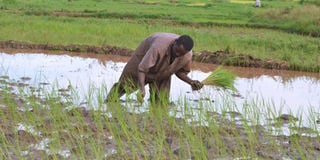Ask your Agronomist: Fertiliser application on rice grown in paddy field

A man transplants rice seedlings to a paddy at Kimbimbi in Mwea. Unlike many other crops, rice benefit from an ammonium source of nitrogen at the early growth stages, but become more efficient on uptake of nitrate nitrogen at the later stage of panicle initiation. PHOTO | FILE | NATION MEDIA GROUP
What you need to know:
- Nitrogen, as a nutrient, is particularly prone to many types of losses, and as such requires careful management to achieve desired yields.
- Unlike many other crops, a rice crop will benefit from an ammonium source of nitrogen at the early growth stage, but becomes more efficient on uptake of nitrate nitrogen at the later stage of panicle initiation.
- Irrigation water management is critical in ensuring that the nutrients applied through the fertilisers have a better chance of being taken up by the crop and not lost either by leaching, volatilisation, denitrification or even immobilisation.
Q: I am a rice farmer in Mwea. Please advise on the best fertiliser programme for growing rice in the region.
Successful production of paddy rice such as is the case in Mwea calls for careful management of two important factors, that is, irrigation water and the fertilisation programme.
Irrigation water management is critical in ensuring that the nutrients applied through the fertilisers have a better chance of being taken up by the crop and not lost either by leaching, volatilisation, denitrification or even immobilisation.
Nitrogen management in paddy rice
Balanced nutrition in rice like all other crops is critical in achieving optimal yields. The application time as well as type and form of the nutrients are essential factors determining the agronomic efficiency of the fertiliser applied.
Nitrogen, as a nutrient, is particularly prone to many types of losses, and as such requires careful management to achieve desired yields.
Unlike many other crops, a rice crop will benefit from an ammonium source of nitrogen at the early growth stage, but becomes more efficient on uptake of nitrate nitrogen at the later stage of panicle initiation.
This is so because in the early stage of low nitrogen demand, the ammonium is taken up and some nitrified in time for plant uptake.
However, in the peak demand periods – at panicle initiation, application of ammonium N fertiliser is inefficient as there are heavy losses from volatilisation more than denitrification and leaching. For this reason, a nitrate source of N is more efficient as the plant quickly takes up the nitrogen.
The fertilisation programme
• A high P fertiliser such as DAP, TSP or an NPK should be applied at 0-5 days after transplanting for early crop establishment. Some potassium is also required and so, if an NPK is not used, then Muriate of Potash (MOP) should be added to provide the potassium.
• At tillering stage, about 21-25 days after transplanting, a nitrogen topdressing should be applied, and this could be from a high nitrogen NPK or straight N fertilisers. NPKs with micronutrients and sulphur would be preferred, such as YaraMila CEREAL fertiliser.
• Final topdressing should be done at panicle initiation, at 45-50 days with preferably a nitrate N fertiliser, and sulphur and micronutrients applied together with MOP to boost the potash for better grain filling and better protein content in the grain.
As already mentioned, all these fertilisation practices must be done under a sound irrigation management system as well as other agronomic activities to optimise the nutrient uptake for the best quality yields.
For crop specific fertiliser recommendations, please consult the following agronomists in your area:
Western and Nyanza, Daniel Mui, 0702466343.
Rift Valley, Dennis Nyandaya, 0702466372.
Central, Robert Ngatia, 0702466318.
Vitalis Wafula, Yara East Africa, Regional Agronomist




